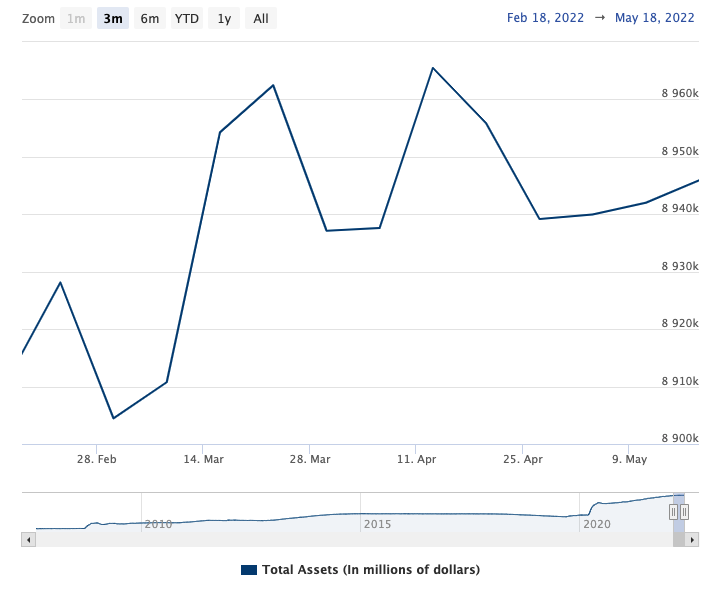Fed Balance Sheet Creeping Upward Again

The Federal Reserve has talked a lot about fighting inflation. But what has it actually done?
In practice, not a lot. It has nudged interest rates up 75 basis points. And while the Fed has ended the massive quantitative easing program that it ran during the pandemic, it pushed balance sheet reduction back from May until June. In fact, the balance sheet has crept upward throughout the entire month of May.
The balance sheet peaked at $8.965 trillion in mid-April. It then fell to $8.939 trillion on April 27, driven primarily by the roll-off of $15 billion in mortgage-backed securities at the end of the month. But since then, the balance sheet has crept upward again. As of May 18, the balance sheet stood at $8.946 trillion. Since that low point on April 27, the Fed has expanded the balance sheet by just under $67 billion.

As you can see from the chart, the balance sheet fluctuates, but it’s clear that the Fed is still engaged in low-level quantitative easing in order to keep the balance sheet from shrinking as bonds mature. Peter made an important point in a recent podcast.
For all the tough talk about how resolute the Fed is and committed to fighting inflation, they continue to create more inflation. Well, if the markets are this weak despite the Fed’s efforts to prop them up with quantitative easing, imagine how much weaker the markets are going to be when the Fed actually begins undermining the markets with quantitative tightening.”
The bottom line is that while the Fed talks about fighting inflation, it hasn’t actually entered the ring. One would think if the Fed was serious about tackling historically high inflation, it would be shrinking its balance sheet, not allowing it to creep upward through the month.
A Reluctant Fed
Reading between the lines and looking at the balance sheet data, it seems clear the Fed doesn’t really want to shrink the balance sheet.
Originally, the plan was to begin quantitative tightening in May. During the May FOMC meeting, the central bank pushed the start date back to June. And the tightening plan central bankers outlined at the last meeting wasn’t particularly impressive.
The Fed said it will allow up to $30 billion in US Treasuries and $17.5 billion in mortgage-backed securities to roll off the balance sheet in June, July and August. That totals $45 billion per month. In September, the Fed plans to increase the pace to $95 billion per month, with the balance sheet shedding $60 billion in Treasuries and $35 billion in mortgage-backed securities.
At $95 billion per month, the Fed could shrink its balance sheet back to pre-pandemic levels in 7.8 years.
Keep in mind, even before the pandemic, the balance sheet was still bloated from the three rounds of QE the Fed ran during the Great Recession.
To put it into perspective, the Fed expanded its balance sheet from under $1 trillion to $4.5 trillion in the wake of the 2008 financial crisis. The balance sheet stood at $4.16 trillion in February 2020, as the coronavirus pandemic started to unfold. That was up from a low of $3.76 trillion in September 2019, when the Fed gave up on tightening because the stock market tanked and the economy was getting wobbly.
That means most of the Treasuries the Fed bought in the first rounds of QE after the 2008 financial crisis remain on the balance sheet today — plus trillions more.
And we’re supposed to think the Fed is going to successfully shrink its balance sheet this time around?
And the FOMC didn’t even hint at how much it intends to shrink its balance sheet, saying only, “Over time, the Committee intends to maintain securities holdings in amounts needed to implement monetary policy efficiently and effectively in its ample reserves regime.”
Needless to say, the moves at this FOMC meeting hardly count as an aggressive move against 8.5% CPI (much less the real inflation rate of somewhere in the neighborhood of 17%.)
The bottom line is that despite all the talk about fighting the inflation fire, the Fed is still spraying gasoline on it.
Call 1-888-GOLD-160 and speak with a Precious Metals Specialist today!
Buka akaun dagangan patuh syariah anda di Weltrade.
Source link





